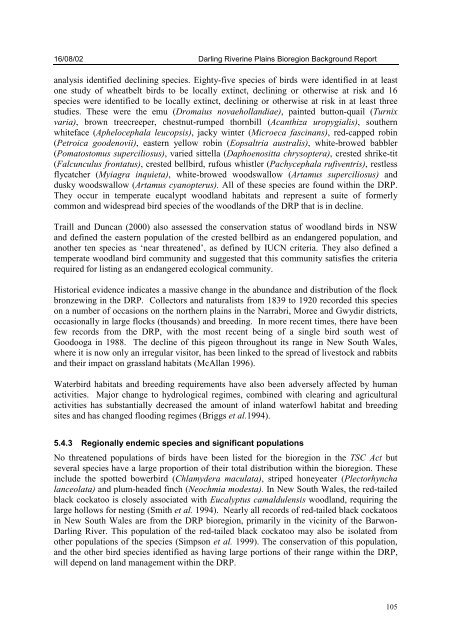DARLING RIVERINE PLAINS BIOREGION Background Report
DARLING RIVERINE PLAINS BIOREGION Background Report
DARLING RIVERINE PLAINS BIOREGION Background Report
Create successful ePaper yourself
Turn your PDF publications into a flip-book with our unique Google optimized e-Paper software.
16/08/02 Darling Riverine Plains Bioregion <strong>Background</strong> <strong>Report</strong><br />
analysis identified declining species. Eighty-five species of birds were identified in at least<br />
one study of wheatbelt birds to be locally extinct, declining or otherwise at risk and 16<br />
species were identified to be locally extinct, declining or otherwise at risk in at least three<br />
studies. These were the emu (Dromaius novaehollandiae), painted button-quail (Turnix<br />
varia), brown treecreeper, chestnut-rumped thornbill (Acanthiza uropygialis), southern<br />
whiteface (Aphelocephala leucopsis), jacky winter (Microeca fascinans), red-capped robin<br />
(Petroica goodenovii), eastern yellow robin (Eopsaltria australis), white-browed babbler<br />
(Pomatostomus superciliosus), varied sittella (Daphoenositta chrysoptera), crested shrike-tit<br />
(Falcunculus frontatus), crested bellbird, rufous whistler (Pachycephala rufiventris), restless<br />
flycatcher (Myiagra inquieta), white-browed woodswallow (Artamus superciliosus) and<br />
dusky woodswallow (Artamus cyanopterus). All of these species are found within the DRP.<br />
They occur in temperate eucalypt woodland habitats and represent a suite of formerly<br />
common and widespread bird species of the woodlands of the DRP that is in decline.<br />
Traill and Duncan (2000) also assessed the conservation status of woodland birds in NSW<br />
and defined the eastern population of the crested bellbird as an endangered population, and<br />
another ten species as ‘near threatened’, as defined by IUCN criteria. They also defined a<br />
temperate woodland bird community and suggested that this community satisfies the criteria<br />
required for listing as an endangered ecological community.<br />
Historical evidence indicates a massive change in the abundance and distribution of the flock<br />
bronzewing in the DRP. Collectors and naturalists from 1839 to 1920 recorded this species<br />
on a number of occasions on the northern plains in the Narrabri, Moree and Gwydir districts,<br />
occasionally in large flocks (thousands) and breeding. In more recent times, there have been<br />
few records from the DRP, with the most recent being of a single bird south west of<br />
Goodooga in 1988. The decline of this pigeon throughout its range in New South Wales,<br />
where it is now only an irregular visitor, has been linked to the spread of livestock and rabbits<br />
and their impact on grassland habitats (McAllan 1996).<br />
Waterbird habitats and breeding requirements have also been adversely affected by human<br />
activities. Major change to hydrological regimes, combined with clearing and agricultural<br />
activities has substantially decreased the amount of inland waterfowl habitat and breeding<br />
sites and has changed flooding regimes (Briggs et al.1994).<br />
5.4.3 Regionally endemic species and significant populations<br />
No threatened populations of birds have been listed for the bioregion in the TSC Act but<br />
several species have a large proportion of their total distribution within the bioregion. These<br />
include the spotted bowerbird (Chlamydera maculata), striped honeyeater (Plectorhyncha<br />
lanceolata) and plum-headed finch (Neochmia modesta). In New South Wales, the red-tailed<br />
black cockatoo is closely associated with Eucalyptus camaldulensis woodland, requiring the<br />
large hollows for nesting (Smith et al. 1994). Nearly all records of red-tailed black cockatoos<br />
in New South Wales are from the DRP bioregion, primarily in the vicinity of the Barwon-<br />
Darling River. This population of the red-tailed black cockatoo may also be isolated from<br />
other populations of the species (Simpson et al. 1999). The conservation of this population,<br />
and the other bird species identified as having large portions of their range within the DRP,<br />
will depend on land management within the DRP.<br />
105

















